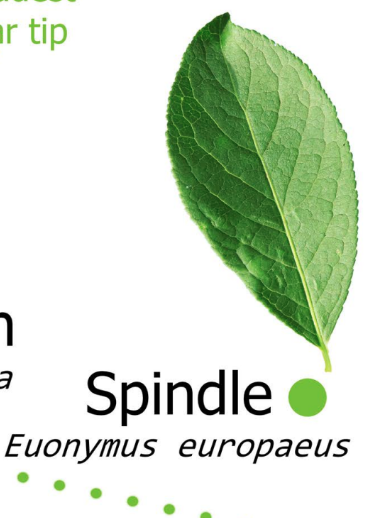A native deciduous tree species in Ireland, commonly found in hedgerows, woodlands, and scrubland.
Recognising the Spindle Tree:
-
Leaves: The leaves of the Spindle tree are opposite, elliptical to lanceolate in shape, and have serrated margins. They are dark green in color and turn vibrant shades of red, orange, and pink in autumn before falling.
-
Bark: The bark of the Spindle tree is greyish-brown and smooth when young, becoming rougher and more fissured with age. It has a distinctive corky appearance and is often mottled with lighter patches.
-
Fruits: Spindle trees produce unique, four-lobed pink to reddish-purple fruits that resemble capsules or pods. These fruits contain bright orange seeds that are revealed when the fruit splits open in autumn.
-
Twigs: The twigs of the Spindle tree are slender, greenish-brown, and have distinctive corky ridges. They often have a zigzag or wavy appearance, especially on older branches.
-
Habitat: Spindle trees are commonly found in hedgerows, woodlands, scrubland, and mixed-species stands. They prefer well-drained soils and are often associated with other broadleaf tree and shrub species.


5 Interesting Facts about the Spindle Tree:
-
Colourful Foliage: The Spindle tree is known for its vibrant autumn foliage, which turns shades of red, orange, and pink in response to cooler temperatures and shorter days. This makes it a popular ornamental tree in gardens and landscapes.
-
Poisonous Fruits: While the fruits of the Spindle tree are visually striking, they are toxic to humans if ingested. They contain compounds known as glycosides, which can cause gastrointestinal upset and other symptoms if consumed in large quantities.
-
Historical Uses: Various parts of the Spindle tree have been used historically for medicinal, ornamental, and practical purposes. The wood was used to make spindles for spinning wool, hence the tree's common name. The fruits were also used in traditional medicine to treat ailments such as fever, diarrhoea, and skin conditions.
-
Wildlife Habitat: Despite their toxicity to humans, the fruits of the Spindle tree are an important food source for birds, particularly thrushes, blackbirds, and waxwings. The seeds are dispersed through the birds' droppings, helping to spread the tree's range and establish new populations.
-
Diverse Habitats: Spindle trees are adaptable and can grow in a variety of habitats, from woodlands and hedgerows to roadside verges and disturbed areas. They are often found in mixed-species stands and provide valuable habitat and food for a wide range of wildlife species.
Uses of the Spindle Tree:
-
Ornamental Planting: Spindle trees are valued in landscaping for their colourful foliage, distinctive fruits, and attractive branching structure. They are often planted in gardens, parks, and landscapes as specimen trees, hedging plants, or understory shrubs.
-
Traditional Medicine: While the fruits of the Spindle tree are toxic to humans, they have been used in traditional medicine to treat various ailments in small doses. Extracts from the fruits were historically used to treat fever, diarrhoea, and skin conditions, although caution should be exercised due to their toxic nature.
-
Wildlife Habitat: Spindle trees provide valuable habitat and food for a variety of wildlife species, particularly birds. The fruits are an important food source for thrushes, blackbirds, and waxwings, especially during the autumn and winter months when other food may be scarce.
Contribution to Biodiversity:
-
Wildlife Food Source: Despite their toxicity to humans, the fruits of the Spindle tree are an important food source for birds, particularly during the autumn and winter months when other food may be scarce. By providing food for birds, Spindle trees support bird populations and contribute to overall ecosystem health and balance.
-
Habitat Provider: Spindle trees provide habitat and shelter for a variety of wildlife species, including birds, insects, and small mammals. Their dense foliage and branching structure provide nesting sites, roosting spots, and protective cover for wildlife, enhancing habitat diversity and complexity in hedgerows, woodlands, and scrubland.
-
Seed Dispersal: Birds play a key role in dispersing the seeds of the Spindle tree through their droppings. This helps spread the tree's range and establish new populations in diverse habitats, contributing to the genetic diversity and resilience of ecosystems.
In summary, the Spindle tree is recognisable by its colourful foliage, distinctive fruits, and corky twigs. It holds cultural significance, provides valuable resources for wildlife, and contributes to biodiversity and ecosystem health in Ireland's hedgerows, woodlands, and scrubland. Additionally, it serves as an ornamental tree, supports bird populations, and enhances habitat complexity in natural ecosystems.
Images taken from the beautiful posters created by Phil Barnett and you can download these and/or purchase other great designs from his online shop.
